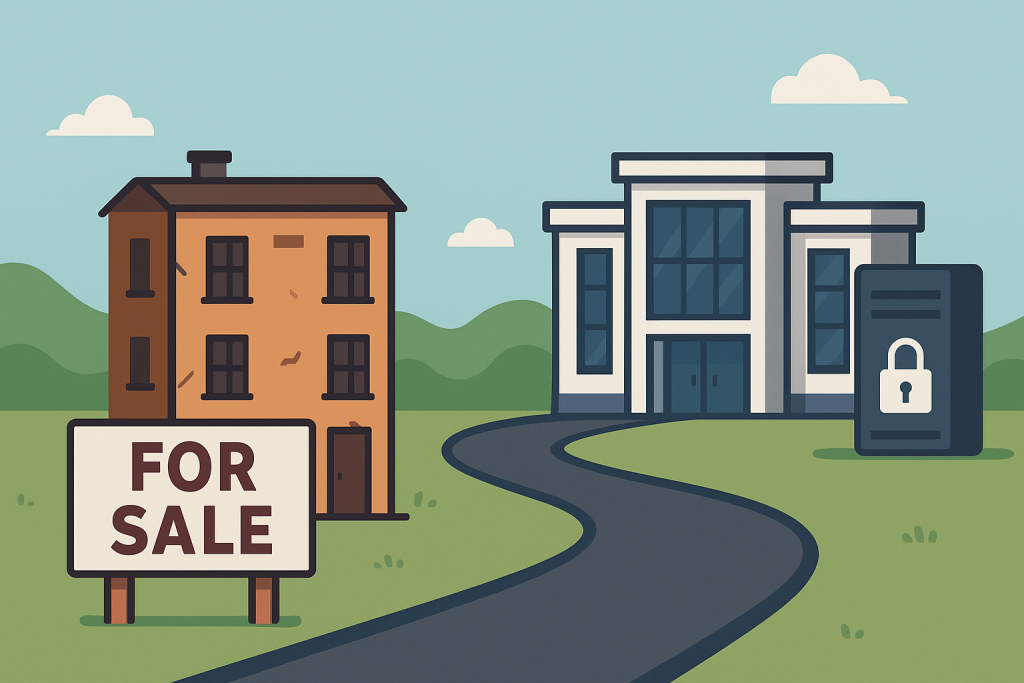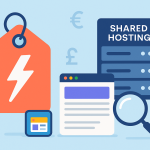Shared hosting is the perfect starting point for almost any website. It’s like renting your first apartment: affordable, all the basics are covered, and you don’t have to worry about the major maintenance. It’s a fantastic way to get your idea online without breaking the bank or needing a degree in server administration.
But, just like that first apartment, you will eventually outgrow it. Your website will get bigger, your audience will grow, and your needs will become more sophisticated. Suddenly, the shared resources feel cramped, the rules feel restrictive, and the performance just isn’t what it used to be.
The question then becomes: When is the right time to move on, and where should you go next?
This is an article for the savvy entrepreneur, the successful blogger, and the growing e-commerce store owner. We’re going to dive deep into the signs that your website is suffocating on shared hosting, what the next steps look like (VPS, Dedicated, Cloud), and how to make that transition seamlessly. By the end, you’ll have a clear, actionable roadmap for your website’s next great leap.
1. The Shared Hosting “Apartment Building” Analogy: What You’re Actually Buying
Before we talk about leaving, let’s quickly solidify what shared hosting is.
Imagine a large apartment building. This building is one massive, powerful server.
- You rent a room (your website): This is your space on the server.
- You share the utilities (CPU, RAM, Bandwidth): This is the core of shared hosting. Every website in the building draws power from the same central supply.
- The landlord handles all maintenance: Your hosting company manages security patches, server updates, and general upkeep.
The Pros: It’s cheap. It’s easy. It’s managed for you. The Cons: If your next-door neighbor (another website on the same server) decides to throw a massive, resource-hogging party (a huge traffic spike or a complex script), your website’s performance suffers. This is often called the “Noisy Neighbor” effect. You have very little control over the environment.
Shared hosting is built for economy, not for scale or guaranteed performance. Once your project moves from a “hobby” to a “business,” this model becomes a liability.
2. The Nine Undeniable Signs You Have Outgrown Shared Hosting
How do you know if you’ve hit the ceiling? It’s rarely one single dramatic event. It’s a slow, frustrating accumulation of small issues that all point to a lack of resources and control.
Here are the nine most critical signs that it’s time to upgrade:
A. Your Website Speed is Tanking (Especially at Peak Times)
This is the most common and damaging symptom. You run a speed test (Google PageSpeed, GTmetrix) in the middle of the night, and the results are okay. But as soon as your primary audience logs on (morning, lunch, after work), your load times crawl from a snappy 1-2 seconds to a sluggish 5-8 seconds or more.
- The Shared Reality: Your host is throttling your resources or, more likely, the collective traffic on the server is simply maxing out the shared CPU and RAM. Your site has to wait in line.
- The Cost: Slow sites kill conversions. Google penalizes slow sites in search rankings. You are literally losing money and visibility every day this continues.
B. You’re Seeing Frequent “503 Service Unavailable” or “Out of Memory” Errors
This is the host’s way of saying, “Stop, you’re using too much power.” Shared hosts have strict, invisible limits on the resources (like the amount of RAM or CPU time) any single account can use.
- The Shared Reality: When a complex query runs, a new plugin is activated, or a legitimate traffic surge hits, your site hits its resource cap and the host kills the process to protect the other sites on the server.
- The Solution: You need guaranteed, dedicated resources that only your site can access.
C. Your Host is Sending You Nagging “Resource Limit” or “CPU Usage” Emails
This is the host explicitly telling you to move on. They are monitoring your account and flagging you for being a “noisy neighbor.”
- The Shared Reality: You are now consuming more than your fair share of the shared resources, and the hosting company is pushing you to a higher, more profitable tier (like VPS).
- Your Response: This is the universe handing you the official paperwork to graduate. Take the hint and upgrade before they suspend your account.
D. Your Monthly Traffic is Consistently Above 10,000-25,000 Visitors
While this is a general guideline, it’s a solid benchmark. Once your site regularly attracts over 10,000 monthly visitors, you are officially in the “medium traffic” category.
- The Shared Reality: A sudden, viral post or a successful marketing campaign that drives 5,000 people to your site at once will almost certainly crash a standard shared host.
- The Upgrade Benefit: You need a home that can not only handle your average traffic but also your peak traffic without collapsing.
E. You Need Advanced Server Configuration or Specific Software
Running a basic WordPress blog? Shared hosting is fine. Running a complex application, a custom e-commerce system, or needing specific server-side languages or database versions? Shared hosting will say “No.”
- The Shared Reality: Shared hosting doesn’t give you “root access.” You can’t install custom software, change core server configurations, or optimize the backend environment to your exact needs.
- The Upgrade Benefit: You need a system that gives you the keys to the engine room.
F. Security and Isolation are Top Concerns (Especially for E-Commerce)
With shared hosting, a security breach on a different, poorly secured website on your server can potentially put your site at risk. You are not perfectly isolated.
- The Shared Reality: While hosts try to isolate accounts, the underlying server kernel is still shared. A security flaw in the server environment could affect every tenant.
- The Upgrade Benefit: Higher-tier hosting (especially VPS and Dedicated) provides a secure, fully isolated environment, giving you control over your own security protocols and firewalls.
G. Your Backups and Recovery are Clunky or Incomplete
Relying solely on your shared host’s backup system is a risk. They often take daily backups, but restoring can be a slow, manual process with a service agent, potentially costing you hours of downtime.
- The Shared Reality: You lack the control to take an instant snapshot, test a restoration, or move the backup to a secure off-site location easily.
- The Upgrade Benefit: Upgrading gives you faster, on-demand backup tools, allowing for near-instantaneous disaster recovery.
H. You are Scaling Your Business, Not Just Your Blog
If your website is the engine of your business—processing payments, managing inventory, or running critical membership functionality—then a reliable, professional-grade platform is a non-negotiable expense, not an option.
- The Shared Reality: You wouldn’t run a factory on residential electrical wiring. Shared hosting is residential. Your business needs a commercial-grade infrastructure.
I. You Simply Want a Faster Time to First Byte (TTFB)
TTFB is the technical measure of how quickly a server responds to a request. On shared hosting, a good TTFB is difficult to guarantee because of all the “noisy neighbors.”
- The Upgrade Benefit: Upgrading gives you dedicated, high-performance resources (like NVMe SSDs and dedicated RAM) that dramatically lower your TTFB, instantly improving user experience and SEO.
3. The Path Forward: Choosing Your Next Home
When you decide to leave the shared hosting apartment building, you have three primary options for your next home. Think of this as moving from an apartment to a condo, or even buying your own custom house.
| Hosting Type | Analogy | Who It’s For | Key Benefit |
| VPS Hosting (Virtual Private Server) | Renting a Condo | Medium-traffic sites, growing e-commerce, developers. | Guaranteed Resources & Root Access. You get a dedicated slice of the server with guaranteed CPU/RAM that is completely isolated from others. |
| Dedicated Server | Buying Your Own House | Massive enterprises, high-traffic SaaS, high-security financial sites. | Total Control & Maximum Performance. The entire physical server is 100% yours. |
| Cloud Hosting | A Dynamic Power Grid | Sites with unpredictable, massive traffic spikes (e.g., flash sales, viral media). | Infinite Scalability. You pay for exactly what you use and can scale resources up and down instantly across a network of servers. |
The Most Common and Smartest Step: VPS Hosting
For 90% of websites that outgrow shared hosting, VPS (Virtual Private Server) is the perfect middle step.
It solves the core shared hosting problem by using virtualization technology to divide the main physical server into several isolated, virtual servers.
Why VPS is the smart move:
- Isolation (Goodbye, Noisy Neighbors): Your virtual server is separate. A massive traffic spike on a neighbor’s VPS will not affect your performance. Your CPU and RAM are guaranteed.
- Root Access (Hello, Control): You get full administrative access to the server environment. You can install custom software, fine-tune security settings, and optimize the server exactly for your application (e.g., a specific version of PHP or a custom database setup).
- Cost-Effective Scalability: VPS is more expensive than shared hosting, but far cheaper than a dedicated server. Most VPS providers allow you to increase RAM, CPU, and storage with a simple click, scaling your power as you grow.
When choosing a VPS, you’ll encounter two main types:
- Managed VPS: The hosting provider still handles all the complex server maintenance, patching, and security updates for you. (Recommended for most people)
- Unmanaged VPS: You are responsible for all operating system updates, security, and maintenance. This is only for users with significant server administration expertise.
Why You Might Jump Straight to Dedicated or Cloud
- Dedicated: Choose this if you are a major enterprise, require absolute peak performance at all times, or have extremely stringent security/compliance requirements (like HIPAA or PCI for large stores). The cost and technical overhead are very high.
- Cloud Hosting: Choose this if your traffic is highly unpredictable. If you get 1,000 visitors one day and 1 million the next, Cloud hosting’s ability to instantly draw resources from a network of servers is unbeatable. It is complex and often billed on a usage basis.
4. The Action Plan: How to Upgrade Without Breaking Your Site
The thought of moving your entire website can be terrifying. Thankfully, the process has become much easier.
Step 1: Analyze Your Current Performance Data (The Proof)
Don’t just guess. Look at your cPanel or hosting dashboard metrics:
- CPU Usage: Is it consistently high (e.g., above 50% for long periods)?
- RAM/Memory Usage: Are you hitting your plan’s limit often?
- Load Time (TTFB): Use tools to monitor this over 24 hours. A consistently high TTFB (over 600ms) suggests resource contention.
Step 2: Choose Your New Host and Plan
Based on your performance data and future goals (refer back to Section 3), select a VPS, Dedicated, or Cloud provider.
- If you chose VPS: Start small. You can always scale up. A plan with 2-4GB of RAM and 2-4 CPU cores is a great starting point for a site that just outgrew shared hosting.
Step 3: Check for Free or Managed Migration
Crucial Advice: The single biggest service your new host can offer is Free Migration.
- Most reputable VPS and Managed WordPress hosts will offer to move your entire website for free, with zero downtime. This involves their technical team cloning your site to the new server, testing it, and then flipping the switch (DNS change) at a time you approve.
- If you are doing it yourself: You will need to manually back up your files via FTP and your database via phpMyAdmin, upload them to the new server, and then update your configuration files—a complex, risky process for non-experts. Leverage the free migration service!
Step 4: Test, Test, Test (The Staging Environment)
Once the migration is complete, and before you change your domain’s name servers (the “flipping the switch” moment), you must test the cloned site on the new server.
- Your host will provide a temporary URL (like a staging link).
- Your Testing Checklist:
- Verify all pages load quickly.
- Test your contact forms.
- Place a test order (if you have e-commerce) to ensure the payment gateway works.
- Log in to your admin area (e.g., WordPress Dashboard) and check for errors.
Step 5: Update Your DNS and Go Live
Once you are 100% confident, you will update your domain’s Name Servers (DNS) to point to the new hosting provider’s IP address.
- The Wait: The change isn’t instant. It takes a few hours (up to 48, but usually much less) for the entire internet to recognize the new location. This is called propagation. Your old and new sites will run in parallel during this time.
- The Clean-Up: After 48 hours, confirm your site is fully loading from the new server, and then you can safely cancel your old shared hosting plan.
5. The Ultimate Payoff: Why the Investment is Worth It
Upgrading is not just about avoiding problems; it’s about unlocking new potential. The investment you make in higher-tier hosting is directly proportional to the professionalism and growth potential of your business.
The Three Major Benefits You Immediately Gain:
- Superior User Experience (UX): A fast website means happy users. They browse longer, they see more of your content, and they are significantly more likely to convert—whether that’s signing up for a newsletter or making a purchase.
- SEO Advantage: Site speed is a confirmed Google ranking factor. By upgrading to a host that guarantees low TTFB and fast load times, you are actively improving your search engine optimization and driving more organic traffic.
- Peace of Mind & Focus: The time you currently spend dealing with “resource limit” errors, calling support about slow speeds, and worrying about downtime is time lost. By upgrading, you hire a reliable, powerful server environment that simply works, allowing you to focus 100% on creating content, marketing, and growing your business.
Shared hosting was a great place to start. But success requires an upgrade. When your website stops feeling like a fun project and starts feeling like a critical, revenue-generating machine, it’s time to move out of the apartment building and into a home that can truly support your ambitious future.



